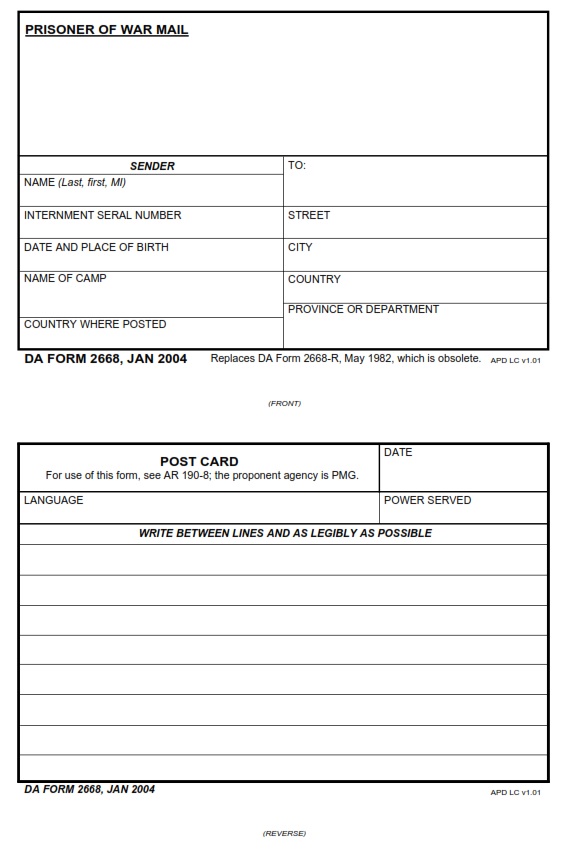Table of Contents
FREE-ONLINE-FORMS.COM – DA Form 2668 – Prisoner Of War Mail (Post Card) – Imagine a postcard traveling through time and space, carrying the weight of emotions, longing, and hope. The DA Form 2668 – Prisoner Of War Mail Post Card is not just a piece of paper; it is a lifeline connecting prisoners of war with their loved ones in the outside world. Each stroke of the pen on this postcard holds significance beyond words, bridging the gap between captivity and freedom. In this article, we delve into the history and impact of these unique postcards that serve as a beacon of light in the darkness of war.
The DA Form 2668 – Prisoner Of War Mail Post Card is more than just a means of communication; it is a symbol of resilience in times of adversity. As we explore the intricate details and regulations surrounding these postcards, we uncover stories of courage, love, and unwavering determination that transcend barriers imposed by conflict. Join us on a journey through the corridors of history as we unravel the power behind each carefully crafted message sent through this humble yet profound form of correspondence.
Download DA Form 2668 – Prisoner Of War Mail (Post Card)
| Form Number | DA Form 2668 |
| Form Title | Prisoner Of War Mail (Post Card) |
| Edition Date | 1/1/2004 |
| File Size | 32 KB |
What is a DA Form 2668?
The DA Form 2668, also known as the Prisoner of War Mail postcard, holds significant historical importance within military communication protocols. Designed specifically for prisoners of war, this form served as a vital means for them to stay connected with their families and loved ones during times of conflict and captivity. Providing a limited space for messages due to security reasons, the form allowed POWs to communicate essential information while adhering to strict regulations.
Each DA Form 2668 was closely monitored by authorities to ensure that no sensitive or classified information was being exchanged. Despite its seemingly simple format, the postcard played a crucial role in maintaining morale and hope among prisoners of war who often endured harsh conditions and isolation. For many soldiers held captive in enemy territories, these postcards represented a lifeline to the outside world, offering a glimpse of normalcy amidst chaos and uncertainty.
Where Can I Find a DA Form 2668?
One might wonder where to find the elusive DA Form 2668 – the prisoner of war mail postcard. The answer lies within the military infrastructure itself. Specifically, these forms are typically available through official military channels such as unit supply offices or designated personnel responsible for handling mail services for deployed troops.
If you’re a concerned family member or friend trying to send well wishes and support to a loved one who is a prisoner of war, reaching out to the appropriate military contacts can help you obtain this essential form. Additionally, online resources and forums dedicated to supporting troops could also provide guidance on how to access and fill out this crucial document for sending messages to prisoners of war. Remember, even small gestures like sending a postcard can make a significant impact on those serving our country in difficult circumstances.
DA Form 2668 – Prisoner Of War Mail (Post Card)
The DA Form 2668, also known as the Prisoner of War Mail Post Card, serves as a vital lifeline connecting individuals detained in enemy hands with their loved ones. In the complex landscape of warfare, where communication is often restricted or monitored, these postcards provide a rare opportunity for prisoners to convey brief messages of reassurance and longing. The simplicity of the postcard format belies its profound impact, offering a channel for human connection amidst the harsh realities of captivity.
For families awaiting news of their loved ones held as prisoners of war, receiving one of these postcards can be both a moment of relief and sorrow. The concise nature of the messages—limited by space and content restrictions—heightens their emotional weight, each word carrying an immense significance. These postcards serve not only as forms of communication but also as symbols of resilience and hope in times of uncertainty. In this age-old tradition of bridging distances and adversity through ink and paper, the power of written words transcends boundaries, offering solace to those separated by conflict.
